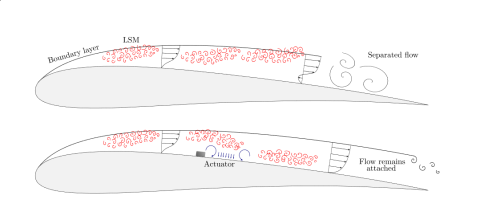This project is part of a collaboration with researchers at the University of Texas at Austin ( David Goldstein , Saikishan Suryanarayanan and Efstathios Bakolas ) to reenergize boundary layers using naturally occurring coherent structures, or large-scale motions (LSMs). These LSMs are modelled as a train of hairpin vortices. Presently, experimental work is being conducted to generate artificial hairpin vortices/LSMs with various methods: synthetic jets, unsteady blowing, etc. Preliminary tests to generate and control artificial LSMs such as those with results shown in Video 1 have been conducted using unsteady blowing.
Further developments of this project involve implementing active flow control on the artificial structures to draw them into the boundary layer to increase wall shear stress and thereby delay or mitigate flow separation. Simultaneous efforts are in progress to model these structure generation and control flow scenarios with direct numerical simulations. Additionally, the collaborators are utilizing experimental data from RPI to reproduce experiments in the open source nek5000 spectral element solver.

Figure 1. Separated flow environment (top) with existing LSMs used to control the separated flow (bottom).
Video 1: Color contours of normalized streamwise velocity in the flow domain (left) and time lapse (right) of the velocity profile at x/D = 10 as artificial LSM.